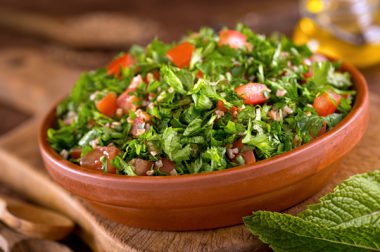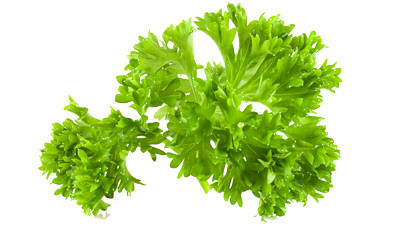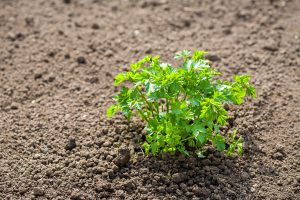Recipes we love
See all recipesFilo pastry sheets with cheese and parsley
A starter full of vitamins and calcium which contribute to the normal functioning of the immune syst...
Lebanese tabbouleh with parsley
An original way of eating a large amount of parsley and mint so you can make the most of all their b...
Health
benefits
Packed with nutrients!
Parsley is so full of useful compounds that it is hard to choose just one nutrient to mention. Of course, since only small amounts of the herb are used at a time, it has a modest nutritional impact, but if used regularly, the benefits are real!
It also contains:
- numerous antioxidants (flavonoids, lutein, etc.)
- vitamin K
Parsley is:
- a source of vitamin B9 (for cellular renewal, particularly important for pregnant women for fetal development, for growing children, and for convalescents)
- a source of potassium (for the nervous system, muscular function, and blood pressure) iron absorption)
- a source of vitamin C (for immune and nervous system health, collagen formation, energy, fatigue reduction, and iron absorption)
- a source of calcium (for bone and teeth health, muscular contraction, blood clotting, and energy) (link). It is easily absorbed by the body.
- a source of iron (for cognitive function, red blood cells, the immune system, energy, and fatigue reduction)
- a source of provitamin A or beta-carotene (for iron metabolism, skin and mucous membrane health, vision, immune system health, and growth)
- a source of fiber (for bowel movement regulation, satiety).
Nutritional
composition
When is the right
time to eat it?
April to November
Its high season lasts from April to November. However, it is available year-round.
Vegetable patch or
urban balcony?
Parsley is an herbaceous biennial that grows well in drained soil rich in humus with some lime content, in full sun or partial shade. It is easy to grow in a window box and is a favorite treat for…slugs!
To learn everything you need to know about growing parsley, read the page on growing advice.
Choosing and
storing parsley
Choose your parsley well:
- SIt should be an intense green color, with no yellow spots, and should not have a spicy odor.
Properly store your parsley:
- In the refrigerator: in the vegetable drawer, in a perforated bag. It also keeps better if it is placed in a glass of water, like a bouquet.
- In the freezer: minced and placed in a freezer bag after drying.
Tips and
tricks
How to prepare parsley
Do it at the last minute! Take the leaves off, mince it, or chop it. Always add it at the last minute, at the end of the cooking process; otherwise it will quickly lose its taste and nutrients.
It can be used fresh, dehydrated, or frozen.
Tip for chopping parsley: Place the bouquets in a glass and trim them with scissors!
Tip for making pesto without basil. No basil? Parsley (especially flat parsley) makes an excellent substitute. Its interesting flavor is a change from the very pronounced taste of basil.
Parsley goes well with…
Raw: It will season and add color to your raw salads! It pairs extremely well with garlic, shallots, and chives.
Persillade (a mixture of minced fresh parsley and finely chopped garlic, in equal proportions or with two thirds parsley and one third garlic) is delicious with meat, fish and shellfish when added just before serving.
Gremolata is made up of equal parts garlic, parsley, lemon zest, and orange zest, all chopped. It is often a condiment for osso buco.
Maître d’Hôtel butter is a “must” for serving alongside grilled meats and snails. This mixture of butter and fresh parsley adds vitamin C to your plate, helping you better take in the iron present in the meat.
Flat parsley is a main ingredient in Lebanese tabbouleh.
Cooked: Parsley is one of the ingredients in a bouquet garni, along with thyme and laurel. It is an excellent match for mushrooms, cooked vegetables, and all soups.
Can everyone
eat it?

Young children
Starting at age two, children can eat small quantities of well-chopped raw parsley, added to a puree or soup.
And everyone else
Did you eat some garlic? Now you need some parsley! Some of its antioxidants trap the sulfur compounds that garlic forms in the mouth, mitigating bad breath.
See plenty of other tips for encouraging children to eat vegetables
Where does it come from?
Origins and varieties
Origins: Native to the Mediterranean basin (particularly Sardinia), parsley is grown year-round, mainly in the Netherlands, Italy, France, and Israel.
Varieties: Different varieties include:
- flat parsley (Petroselinum crispum)
- curly parsley (P. crispum crispum)
- Italian parsley (P. crispum neapolitanum)
- Hamburg or Hamburg root parsley (P. crispum tuberosum)
All have their benefits and specificities and go well in particular recipes.



 Artichoke
Artichoke  Bell pepper
Bell pepper  Vegetable garden: growing beetroot
Vegetable garden: growing beetroot 










